Publisher Pandasaurus Games continue their hot streak of visually striking family titles with Bruno Cathala and Corentin Lebrat’s Trek 12: Himalaya, a roll & write themed around mountaineering. I have grown inordinately fond of Pandasaurus in a relatively short period of time. I’m not the only one, as evidenced by Meeple Mountain’s reviews of Wild Space, That Time You Killed Me, and The Loop. The care they put into every title is evident, and they have a knack for publishing designs that are satisfying, engaging, and approachable.
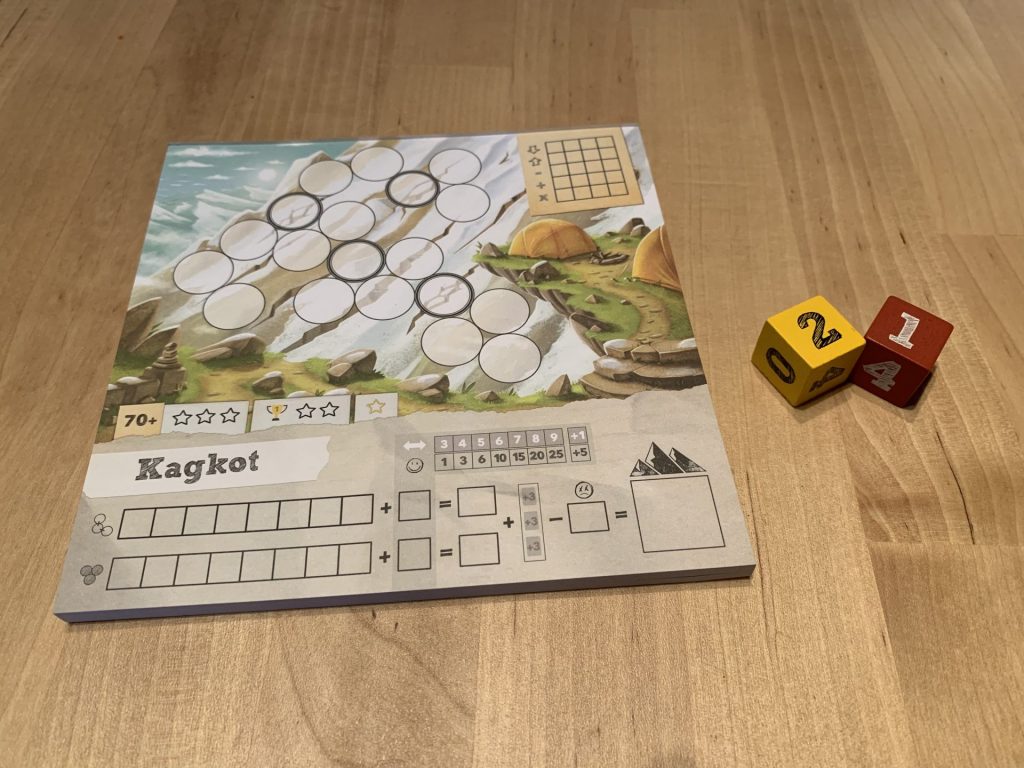
Trek 12 follows the roll & write formula to a T. Players take turns rolling two dice. The result of each roll is used simultaneously by everyone to add a number to the mountain on their individual player sheets. The first number goes anywhere you want, which is thematically suspect, but let’s assume you’re a wealthy mountaineer with access to a helicopter. All subsequent numbers have to be adjacent to previously filled in circles, with the goal of creating Fixed Lines (adjacent sequential numbers) and Mapped Zones (contiguous areas of the same number). You’ll want to be careful about where you place your numbers, because there’s a penalty for any circles that aren’t a part of either a Fixed Line or a Mapped Zone once the game has ended.
The number selection mechanism is pretty clever. The player sheets have a 4×5 grid in the upper right corner where you cross off the next available box in any given row to either use the value of the lower die, the higher die, subtract the lower die from the higher die, add the dice, or multiply the dice together:
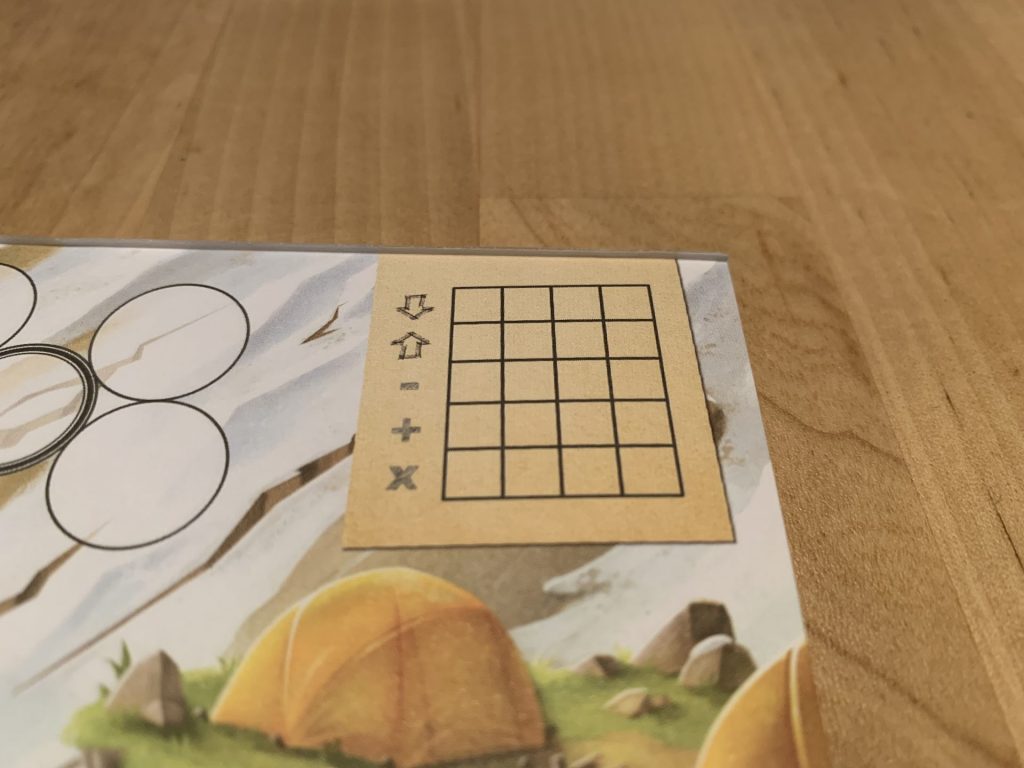
By the end of the game, you’ll have used all but one of the squares in the grid, which adds an ever-increasing thrum of tension as the game goes on. My favorite part of Trek 12 is the low rumble of unrepeatable words that emerges as players see their options narrowing, erupting into a full-on symphony of vulgarity as everyone finds themselves wanting to use an option they’ve already maxed out. Suffice it to say that I have not played this game with children.
Climb Ev’ry Mountain
Trek 12 has three modes: Trek Mode, Free Solo Mode, and Expedition Mode. Trek Mode is a single competitive round, climbing any one of the three included mountains. Free Solo Mode is for solo play, and uses a smart, simple system to create a remarkably balanced opponent. People who enjoy a quick, low-stress filler with coffee in the morning will find themselves well-served by Free Solo Mode.
Expedition Mode has players competing to earn the most stars across three climbs. Players can gain access to Assist Cards, which let you cheat various rules, and the game introduces some proto-legacy elements in the form of challenge envelopes. These envelopes are marked with feats such as “have a Mapped Zone with exactly seven circles” or “have a Fixed Line exactly nine circles long,” and can be opened by the first player to achieve the depicted challenge. Inside are new Assist Cards that get added to the deck, Free Solo opponents of increasing difficulty, and guides, along with other surprises that I won’t disclose here. The guides can only be used by players who have earned them in the past—you write your name on the back of the card as a permanent record of your achievement—and they grant abilities that make climbing easier.

The envelopes are a fun idea, but my experience is mixed. For one, it’s a stretch to suggest that anything in Trek 12 is done with intentionality, so accomplishing a challenge doesn’t feel like an achievement so much as it feels like you got lucky. For another, only one player can open a new envelope each trek, and the hierarchy described in the rulebook prioritizes the easier challenges over the more difficult ones. The designers do have a good reason for doing this, but that reason only becomes clear once you’ve opened those later envelopes, and it doesn’t take the sting out of completing an exceptionally difficult challenge earlier than everyone else without getting the reward. There is absolutely a touch of contradiction to these two points.
Ford Every Stream*
*In the expansion, Trek 12: Amazonia, which is not reviewed here.
I have confirmed once and for all during my time with Trek 12 that I do not like most roll & writes, but I think this is a consequence of shared design choices rather than something inherent to the form. Most roll & writes seem to do everything they can to eliminate downtime. Everyone uses the dice or the cards simultaneously, and nobody sits, nobody waits. This focus on eliminating even a moment’s pause comes at a cost, though: these are games that you play at the same time as your friends, rather than with your friends. That’s neither inherently good nor inherently bad, it’s a matter of preference, though in my case it seems to be decisive. Lost Cities: Roll & Write and the Ganz Schön Clever series, the only approachable roll & writes that haven’t migrated out of my collection after a couple of plays, have two things in common: both games feature combos, which Trek 12 does not, and both give the active player the ability to affect what choices the other players have.
Trek 12 is the kind of game you’d describe as pleasant. It passes by inoffensively, if also unremarkably. Non-interactive roll & writes can only hold my attention for about as long as it takes to figure out how to play well, and Trek 12 offers vanishingly little in terms of a puzzle. Personally, I’m happy to trade in my hiking boots for some other footwear. If you’ve never tried a roll & write, I would recommend starting with Lost Cities: Roll & Write, Ganz Schön Clever, or even Cartographers. I’m not a big fan of that last one, but it’s popular for a reason. If, on the other hand, you enjoy roll & writes as a genre, then you may find Trek 12: Himalaya worth the climb.


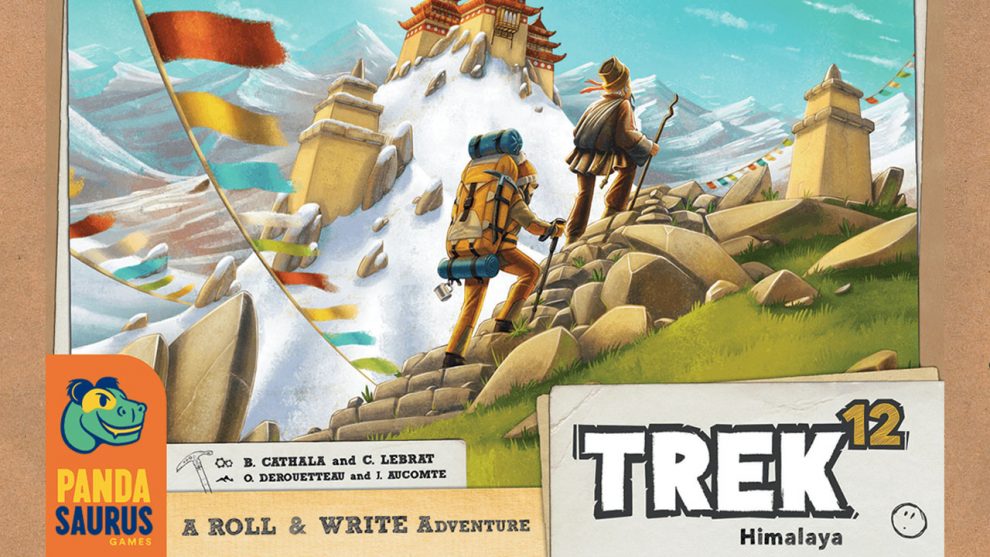


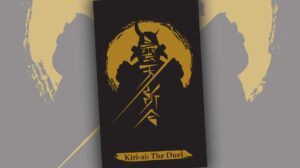

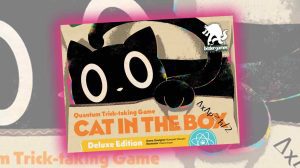




Add Comment